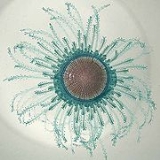
Porpita porpita
Encyclopedia
Porpita porpita, commonly known as the blue button, is a marine organism consisting of a colony of hydroids found in tropical waters from California
to the tropical Pacific
, the Atlantic and Indian oceans see distribution at the Encyclopedia of Life It is often mistaken for a jellyfish, but although jellyfish and the blue buttons are part of the same phylum
(Cnidaria
), the blue button is part of the class
Hydrozoa
.
It plays a role in the food web, as its size makes it easy prey for several organisms. The blue button itself is a passive drifter, meaning that it feeds on both living and dead organisms that come in contact with it. It competes with other drifters for food and mainly feeds off of small fish, eggs, and zooplankton
. The blue button has a single mouth located beneath the float which is used for both the intake of nutrients as well as the expulsion of wastes.
It is preyed on by Glaucus atlanticus
(common names sea swallow, blue glaucus) and Violet Sea-snails of the genus Janthina
.
California
California is a state located on the West Coast of the United States. It is by far the most populous U.S. state, and the third-largest by land area...
to the tropical Pacific
Pacific Ocean
The Pacific Ocean is the largest of the Earth's oceanic divisions. It extends from the Arctic in the north to the Southern Ocean in the south, bounded by Asia and Australia in the west, and the Americas in the east.At 165.2 million square kilometres in area, this largest division of the World...
, the Atlantic and Indian oceans see distribution at the Encyclopedia of Life It is often mistaken for a jellyfish, but although jellyfish and the blue buttons are part of the same phylum
Phylum
In biology, a phylum The term was coined by Georges Cuvier from Greek φῦλον phylon, "race, stock," related to φυλή phyle, "tribe, clan." is a taxonomic rank below kingdom and above class. "Phylum" is equivalent to the botanical term division....
(Cnidaria
Cnidaria
Cnidaria is a phylum containing over 9,000 species of animals found exclusively in aquatic and mostly marine environments. Their distinguishing feature is cnidocytes, specialized cells that they use mainly for capturing prey. Their bodies consist of mesoglea, a non-living jelly-like substance,...
), the blue button is part of the class
Class (biology)
In biological classification, class is* a taxonomic rank. Other well-known ranks are life, domain, kingdom, phylum, order, family, genus, and species, with class fitting between phylum and order...
Hydrozoa
Hydrozoa
Hydrozoa are a taxonomic class of very small, predatory animals which can be solitary or colonial and which mostly live in saltwater. A few genera within this class live in freshwater...
.
Characteristics
The blue button lives on the surface of the sea and consists of two main parts: the float and the hydroid colony. The hard golden-brown float is round, almost flat, and is about one inch wide. The hydroid colony, which can range from bright blue turquoise to yellow, resembles tentacles like those of the jellyfish. Each strand has numerous branchlets, each of which ends in knobs of stinging cells called nematocysts. The blue button sting is not powerful but may cause irritation if it comes in contact with human skin.It plays a role in the food web, as its size makes it easy prey for several organisms. The blue button itself is a passive drifter, meaning that it feeds on both living and dead organisms that come in contact with it. It competes with other drifters for food and mainly feeds off of small fish, eggs, and zooplankton
Zooplankton
Zooplankton are heterotrophic plankton. Plankton are organisms drifting in oceans, seas, and bodies of fresh water. The word "zooplankton" is derived from the Greek zoon , meaning "animal", and , meaning "wanderer" or "drifter"...
. The blue button has a single mouth located beneath the float which is used for both the intake of nutrients as well as the expulsion of wastes.
It is preyed on by Glaucus atlanticus
Glaucus atlanticus
Glaucus atlanticus is a species of small-sized blue sea slug, a pelagic aeolid nudibranch, a marine gastropod mollusk in the family Glaucidae...
(common names sea swallow, blue glaucus) and Violet Sea-snails of the genus Janthina
Janthina
Janthina is a genus of small to medium-sized pelagic or planktonic sea snails, marine gastropod molluscs in the family Janthinidae, commonly known as the "purple snails" or the "violet shells". -Description:...
.

